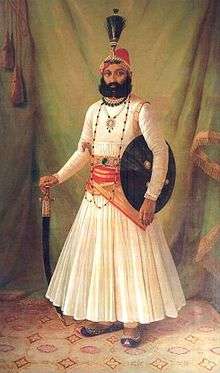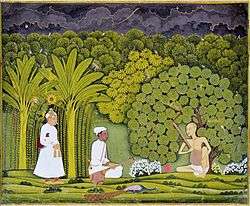Jama (coat)
The term jama refers to a long coat which was popular in South Asia during the Mughal period.
Styles
Some styles of the jama were tight around the torso but flared out like a skirt to below the knees or the ankles. Other styles, such as the chakman jama, ended at around the knees. The sleeves tended to be full.[1] The jama was fastened to either side with strings with some styles also opening at the front.[2] What was originally male dress was also adopted by women who wore the jama with a scarf and tight fitting pajamas.[3] The ties of the upper half of the jama are taken under the armpit and across the chest.[4]
A particular style of jama was the pointed jama which was like the standard Mughal jama but the skirt fell in four to six points instead of the circular hem of the Mughal jama.This jama may be derived from the Rajput court's takauchiah[5] and therefore could be of local origin.[6] During the Sikh reign the jama was no longer flowing but shorter and often tucked up around the waist to allow freedom of movement.[7] During the 19th and 20th centuries A.D. the jama was reduced to a shirt like garment in the northern (upper) parts of British India.[8]
Photo gallery
-

The commander of the Imperial Guard of Delhi
-

Ghulam Murtaza Khan The Delhi Darbar of Akbar II
-

NAWAB OF OUDH, ASAF-UD-DAULA, LUCKNOW, INDIA, CIRCA 1785-90
-

Nawab Shuja al-Daula and his heir Asaf al-Daula in Faizabad
-

Three men in traditional dress, mosaic, Udaipur, Rajasthan, India
-

Raja Ravi Varma, Maharaja Fateh Singh
-

The vizier Qamar ud-Din circa 1735
-

Akbar and Tansen visit Haridas
-

Mughal Army artillerymen during the reign of Akbar.
-
.jpg)
Officer of the Mughal Army, c.1585 (colour litho)
Modern use
In Gujarat, the jama began to lose popularity by the end of the 19th century A.D.[9] However, men in parts of Kutch still wear the jama also known as the angarkha[10] which has an asymmetric opening with the skirt flaring out to around the hips.[11] However, some styles fall to below the knees.
-

Man on the left in Gujarati jama/angarkha
See also
References
- ↑ Elizabeth J. Lewandowski(2011) The Complete Costume Dictionary
- ↑ Goverdhan Panchal (1983) Bhavāī and Its Typical Āhārya: Costume, Make-up, and Props in Bhavāī, the Traditional Dramatic Form of Gujarāt
- ↑ G. J. Sumath (2007) Elements of Fashion and Apparel Design
- ↑ Cohn, Bernard S. (1996) Colonialism and Its Forms of Knowledge: The British in India
- ↑ Condra, Jill (2008) The Greenwood Encyclopedia of Clothing Through World History: 1501-1800
- ↑ Krishna Chaitanya (1992) History of Indian Painting: Rajasthani Traditions
- ↑ Kumar, Raj (2006) Paintings and Lifestyles of Jammu Region: From 17th to 19th Century A.D.
- ↑ Miller, Daniel (2001) Consumption: The history and regional development of consumption
- ↑ Ghurye, Govind Sadashiv (1966) Indian Costume
- ↑ Tierney, Tom (2013) Fashions from India
- ↑ Sarosh Medhora (02.09.2000) The Tribune. Focus on men’s formals
| ||||||||||||||||||
| ||||||||||